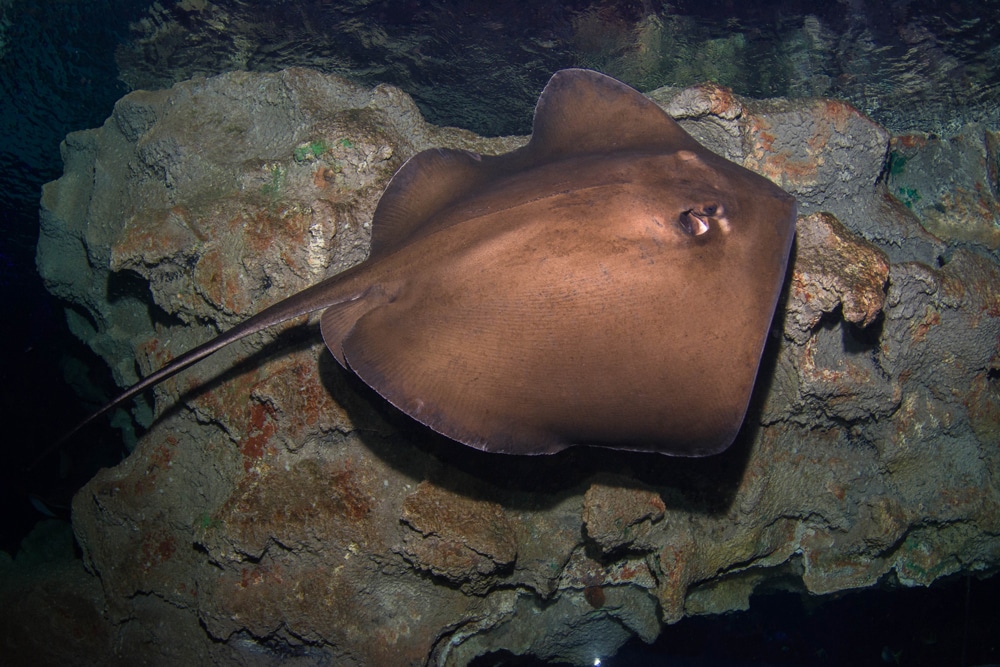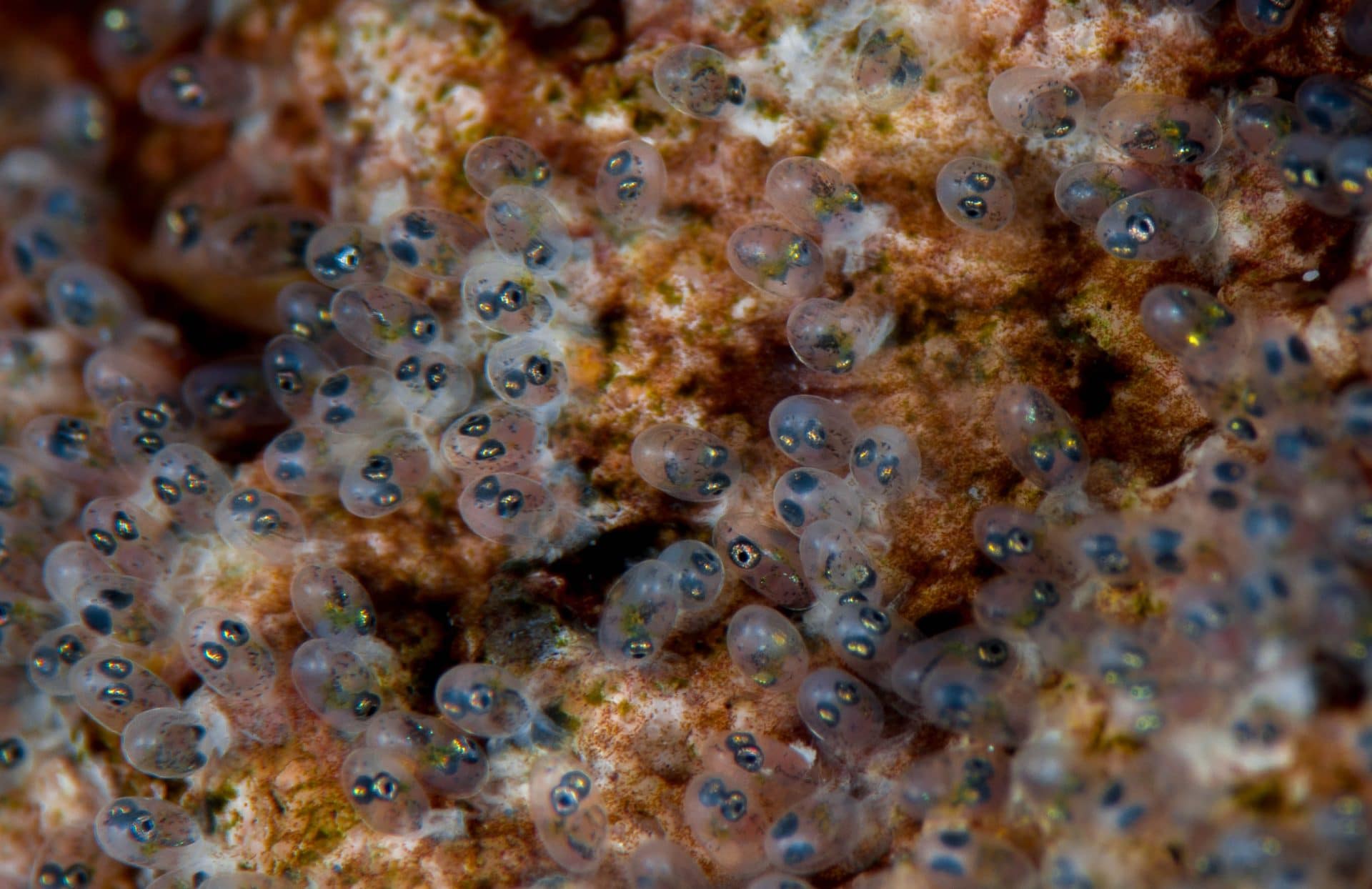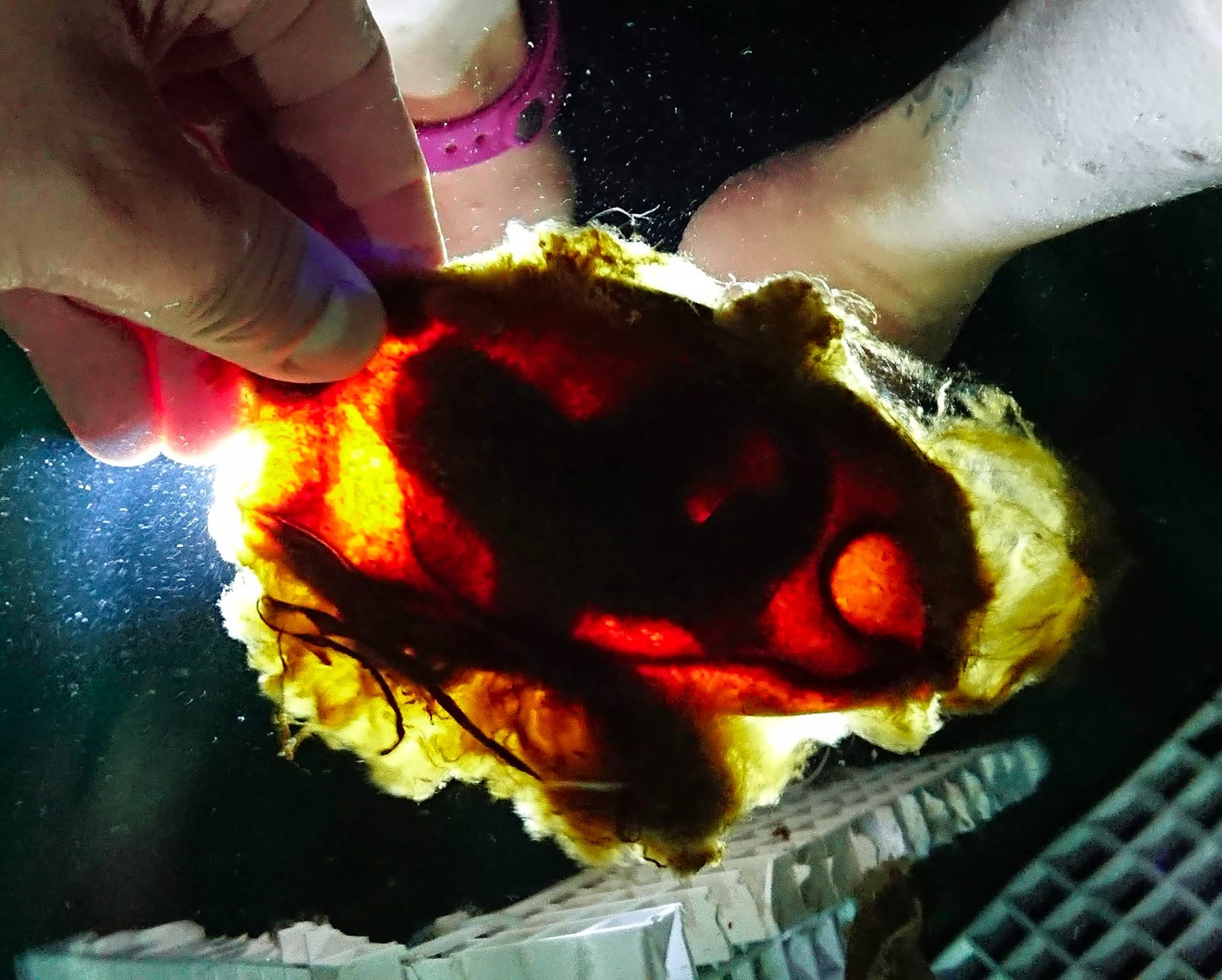Marine Life & Conservation
Breeding at Blue Planet

Breeding in the main tank at Blue Planet
Here at Blue Planet Aquarium we have many animals that live in our main tank, everything from our Sand Tigers all the way down to our Goliath Grouper. But there are a few animals in our main tank that breed on a more than Regular basis. In this article we are going to talk about three of them.
The first one is instantly recognisable as it is one of our signature animals, the Southern Atlantic Stingray. This species can grow up to nearly 5 feet across, with males being significantly smaller at around 2 feet across. Here at Blue Planet we have six adult stingrays, one male and five females with many of their offspring in a separate section of the tank. There are two main females who are breeding, and their names are “Big Bertha” and “Greedy” and we usually expect a litter from each between July and August, this can be anything between 2 – 6 pups on average per litter.
When we find pups in the tank we immediately drop whatever task we’re doing at the time and grab the ray nets (a specially designed flat net that can zip-up) in order to catch them. Every time we catch a pup we will keep going back into the tank until we’re satisfied that all pups have been captured. In the immediate days following the initial birth we will keep our eyes out for any other pups that may appear during the next few days.
Once captured the animals are placed in quarantine which is separate from the main exhibit. They’re kept here for around 6 weeks just so they get used to hand feeding and so that they can grow slightly before they go into the reef section, which is a smaller section of the main tank away from the larger sharks. The animals are kept until they’re large enough to either be moved to a different collection or go on display.
The next animal is probably the least noticed by our guests, it’s a small fish called a Sergeant-Major Damselfish. In the last year we’ve had an unbelievable number of clutches of such a vast amount that we’re finding new nests every day. The way in which they breed is quite fascinating.
Sergeant-Major Damselfish males lure females in with audio cues and “Signal Jumping” – this is where the male will swim erratically up and down, once the female has been attracted they will both change from their light blueish-green colour and turn almost completely dark blue until you can barely see their stripes, and males will develop a bright white patch on his cheek.
The female will lay up to 20,000 eggs and apparently there can be up to four females that add to any one clutch. Both males and females perform a kind of Ballet when laying eggs as they spin around with a head to tail position and then the female breaks away to deposit her eggs and as she finishes a clutch the male descends to fertilise them, this happens until all the eggs have been laid. The eggs are laid to the side of rocks and corals, usually on the roof of overhangs to maximise protection.
Males will guard their clutch ferociously and are now known by the dive team as the most aggressive animal in the tank; they’ve even been seen attacking the Sand Tigers (even though it doesn’t seem to bother them). Males will then spend the next 5-7 days of the gestation period constantly guarding and aerating them to stop fungus from settling on the eggs which would kill them, and just before hatching the eyes on the larvae turn a green colour.
Unfortunately due to the nature of the tank and larvae, we are still trying to figure out how we can harvest the fry to rear them in quarantine but unfortunately you need to be there at the moment they hatch and that usually happens at night. We have placed terracotta tiles in the tank to try and entice them to lay eggs on them so that they can be harvested. Even though we’re still trying to figure out how to harvest them it appears nature is best as we’ve actually seen young fish thriving in the main exhibit.
The final animal is the most cryptic of them all and this is of course Bamboo Sharks. These Sharks spend most of their days sleeping in caves, holes and under overhangs; they’re shy until feeding time and then they’re our best friends. This Shark species lays eggs called “Egg cases/Mermaids Purses” and they lay their eggs around stems of coral or around rockwork. They do this by swimming very quickly over rockwork until the threads of the egg “hook” onto the rocks or coral and then they immediately swim quickly around in big circle causing the egg to slowly be pulled out and wrapped up against the piece of rockwork.
Now this is where the egg would stay if we didn’t find it, but once we find an egg we check them by “candling the egg” which is simply holding up to the light or shining a torch through it; if we see a yolk then it’s a viable egg. There are times we do this and see a shark pup still developing inside which is always a true joy to see. Once we’ve checked the egg is viable, we remove it and place it in our Shark hatchery to develop. The gestation period is usually around 4-5 months, but we check the progress by candling them just to monitor how they’re doing. When they hatch, they have very striking black and white stripes which are used to mimic White-Banded Sea Snakes, as these snakes in their native Indian Ocean habitat would be avoided by most predators (Zebra Sharks also use this form of mimicry). The pups stay in the hatchery until they’re around 10-12 inches long and are trained to feed from your hands and then we move them to another collection.
So, there you have it: Three amazing animals that breed in just our main tank exhibit alone. We do have many other breeding projects here at Blue Planet Aquarium which I’ll be covering in future blog posts.
For more information please visit the Blue Planet Aquarium website by clicking here.
Follow Donovan on Instagram at www.instagram.com/donovans_reefs
Marine Life & Conservation
Paul Watson Released as Denmark Blocks Japan’s Extradition Bid

Renowned anti-whaling activist Paul Watson has been released from custody in Greenland after spending five months in detention. Denmark’s Justice Ministry rejected Japan’s request for his extradition, citing insufficient guarantees that his time already served in custody would be credited against any potential sentence.
The 74-year-old Canadian-American was arrested on July 21 in Nuuk, Greenland’s capital, when his ship docked to refuel. His arrest was based on a 2012 Japanese warrant related to a 2010 encounter in Antarctic waters. Japan alleged Watson obstructed operations and caused damage to a whaling research ship during efforts to disrupt illegal whaling. Watson has consistently denied these claims, maintaining his commitment to marine conservation.
Denmark, which oversees extradition matters for Greenland, concluded that while the legal conditions for extradition were met, the lack of assurances from Japan regarding time-served credit made extradition untenable.
In a video shared by his foundation, Watson expressed gratitude and relief, saying, “After five months, it’s good to be out… and good to know they’re not sending me to Japan.” He added that the most difficult part of his time in custody was being separated from his two young sons.
Watson is a pioneering figure in marine conservation, known for founding the Captain Paul Watson Foundation in 2022 after decades of activism with the Sea Shepherd Conservation Society. His bold efforts to defend marine life have earned him widespread support, including from celebrities and conservationists. His work has also been featured in the acclaimed reality TV series Whale Wars.
Watson’s lawyer, Jonas Christoffersen, praised the decision, stating, “We are happy and relieved that Paul Watson is now free.” He added that Watson is eager to reunite with his family and continue his vital work.
The arrest occurred while Watson’s vessel, the M/Y John Paul DeJoria, was en route to the North Pacific with a team of 26 volunteers to intercept a Japanese whaling ship. His foundation described the arrest as politically motivated and emphasized that Watson’s actions were focused on ending illegal whaling practices.
Japan resumed commercial whaling in 2019 after leaving the International Whaling Commission, asserting that whale meat is a cultural tradition. Conservationists, however, continue to challenge these practices, highlighting their impact on marine ecosystems.
Despite the challenges, Watson remains steadfast in his mission to protect marine life and bring attention to whaling practices. His dedication to ocean conservation has made him a globally respected advocate for the environment.
Marine Life & Conservation
12 Days of Zero-Waste Fish-mas

This holiday period, the Marine Conservation Society, the UK’s leading ocean membership charity, invites you to make some simple changes to eating fish this Christmas to help our seas.
Dr Kenneth Bodles, Head of Fisheries and Aquaculture at the Marine Conservation Society, said, “During the festive season, our consumption increases, but so does waste. Sustainability isn’t just about where food comes from – it’s also about how you use it. By reducing waste and making the most out of your seafood, you’re not only taking steps to be more ocean-friendly, but can also help to cut costs during what is often one of the most expensive times of the year”.
The Marine Conservation Society has compiled twelve tips on how to consume seafood sustainably with zero-waste this Christmas:
Buy whole fish instead of fillets
Instead of fillets, consider buying whole fish such as salmon, hake, or lemon sole. By adopting a “nose to tail” approach with cooking, whole-baked fish not only feeds a crowd, but also helps to minimise waste and maximise sustainability by using up every part of the animal, including bones, skin, and fat.
Make fish stock
Leftover fish bones or shells can be put to good use by boiling them to make a nourishing fish stock or bisque. This can be frozen and preserved for later use and makes for a flavourful base in a soup.
Make your own fish pâté
Avoid waste by turning leftover fish, such as smoked mackerel or salmon, into a delicious pâté by blending with cream cheese and lemon. Perfect when paired with crackers.
The sustainability of salmon and mackerel varies depending on where and how it is caught or farmed. For more information on green-rated options, check the charity’s Good Fish Guide.
Buy frozen
By purchasing seafood that is frozen or vacuum-packed, this helps to reduce waste by extending the shelf life of your food.
Fish pie
If you’re wondering what to do with leftover cooked fish, why not opt for a classic fish pie with mashed potatoes, leeks, and a cheesy sauce? A sure crowd pleaser on Boxing Day.
Use the head
Don’t forget the fish head! The meat is incredibly tender and flavourful. The charity recommends a cod’s head curry or recreating Fallow’s renowned cod’s head in siracha butter.
By stretching your ingredients further, not only is this a more sustainable way to enjoy seafood, but also cost-effective by repurposing leftovers and cooking creatively.
Boxing Day brunch
Mix leftover kippers or smoked salmon with scrambled eggs for a tasty, zero-waste, Boxing Day brunch.
For best choice, make sure you buy kippers, or herring, from the North Sea and the North Irish Sea.
Zero-waste storage
A top tip from the Marine Conservation Society to avoid waste is freezing fish offcuts to save for future use.
Crisp up the skin
Even leftover fish skin can be turned into a quick savoury snack by crisping it up in an air fryer with a little olive oil and salt.
Anchovies two ways
Leftover anchovies can either be blended with butter to make a delicious anchovy butter or tossed into pasta for a hit of umami flavour.
The charity recommends opting for anchovies caught in the Bay of Biscay for best choice.
Fishcakes
For an easy, zero-waste meal, leftover seafood trimmings can be mixed with mash and fried in breadcrumbs to make fishcakes.
Pickled mussels
Try pickling mussels in 1:1 vinegar and water, with a dash of sugar for a sustainable, zero-waste snack that can be enjoyed well beyond the festive season.
Mussels farmed in the UK are a seafood superhero. Grown using low-impact methods and harvested by hand, they get all the food they need from the sea around them. This makes them one of the most sustainable, ocean-friendly, and cost-effective seafood options.
Players of People’s Postcode Lottery have raised £6.6M towards the Marine Conservation Society’s vital work in making seafood more sustainable.
Laura Chow, Head of Charities at People’s Postcode Lottery, said: “Fish is a festive favourite for many, but making sustainable choices when it comes to how we buy and eat seafood makes all the difference for our ocean. Support from players of People’s Postcode Lottery has helped the Marine Conservation Society further its sustainable seafood work, so that we can all enjoy healthier, better protected seas.”
The Marine Conservation Society encourages you to make sustainable seafood choices a year-round habit, not just for Christmas. To check how sustainable the seafood on your plate is, you can visit the charity’s Good Fish Guide. The Guide helps consumers and businesses identify the most sustainable seafood using a simple traffic light system, based on where and how species are caught or farmed. Green is the best choice, amber means improvements are needed, and red indicates fish to avoid buying.
Zero-waste gift idea
Why not embrace a zero-waste Christmas by gifting a membership to support marine conservation? It’s a meaningful, low-waste gift that helps protect our ocean for generations to come. Memberships start from as little as £5 a month – the price of a sandwich and drink from your local coffee shop.
Find the latest sustainable seafood advice for wild-caught and farmed seafood on the Good Fish Guide, downloadable to your phone from www.mcsuk.org/goodfishguide.
-

 News2 months ago
News2 months agoIconic SS United States to become the World’s Largest Artificial Reef
-

 News3 months ago
News3 months agoBook Review – 52 Assignments: Underwater Photography
-

 Gear News3 months ago
Gear News3 months agoDYNAMICNORD – New German diving brand enters the British market
-

 News3 months ago
News3 months agoExploring Cenote El Pit: A Diver’s Dream
-

 Gear News3 months ago
Gear News3 months agoTry BARE drysuits (and maybe even win one!) this Friday with Sea & Sea at North West Dive Fest
-

 Marine Life & Conservation3 months ago
Marine Life & Conservation3 months agoBook Review: Coral Triangle Cameos
-

 Blogs2 months ago
Blogs2 months agoDive the Egyptian Red Sea this Autumn with Regaldive
-

 News3 months ago
News3 months ago2024 Ocean Art Underwater Photo Competition Announced


















